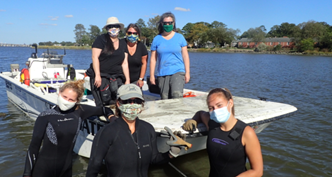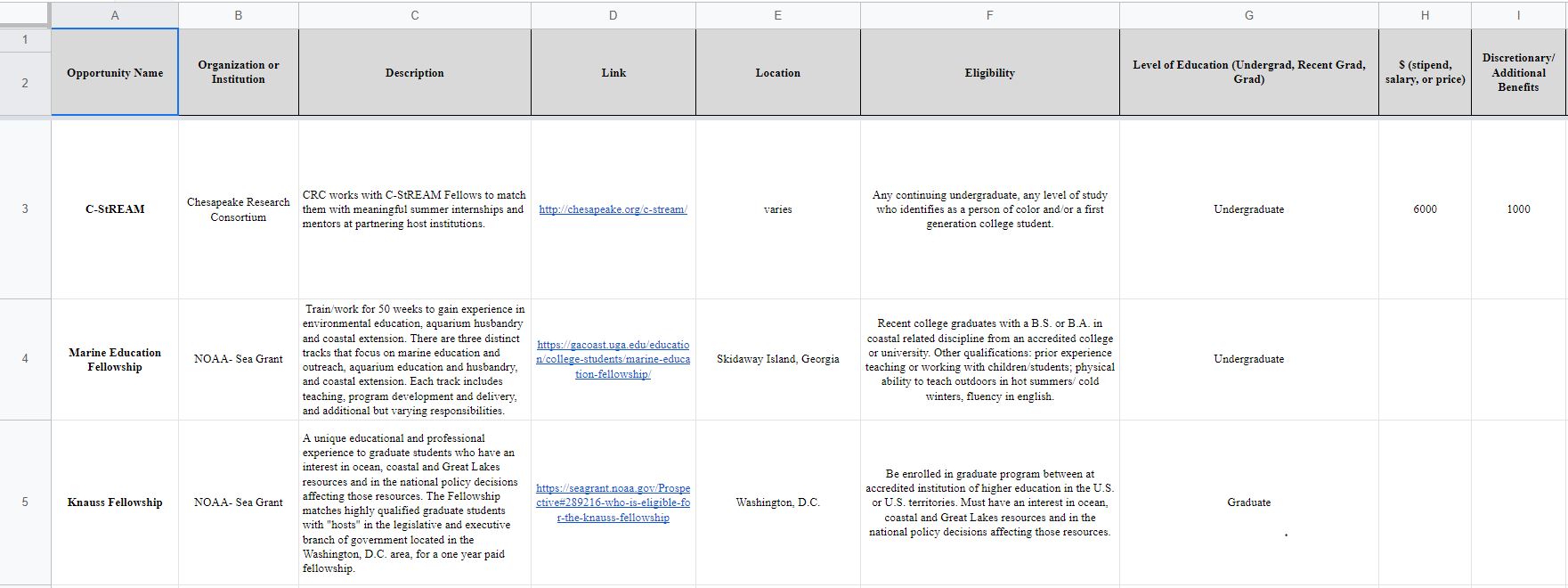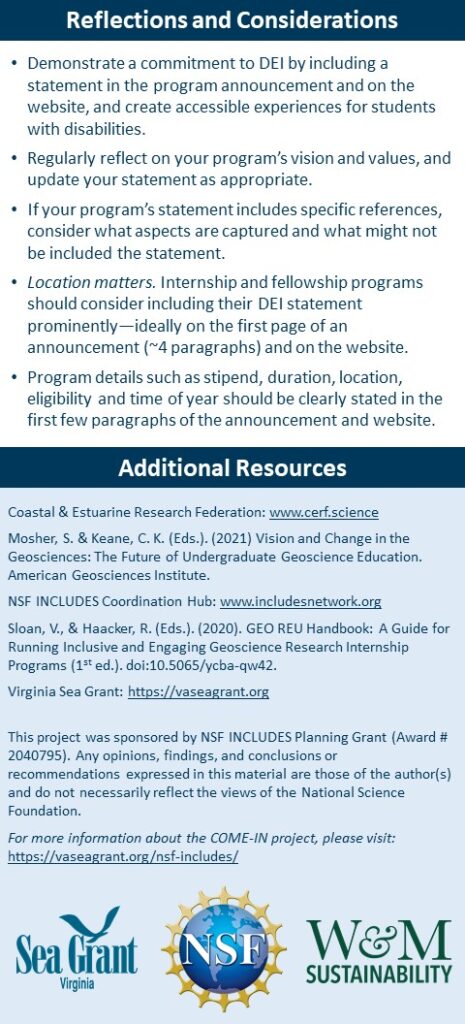Experiences

The VIMS REU team participating in fieldwork
Diving Deep
A Fresh Look at Internships & Fellowship Opportunities
By Colleen Norton ’21
In the summer of 2020, the murder of George Floyd sparked demonstrations across the U.S. in support of the countless minorities, specifically Black people, that have been subject to police brutality. For many people, these demonstrations shed light on systemic racism and institutional inequalities that are pervasive throughout the U.S. and around the world. People started actively seeking ways to be involved, show support, and/or make an impact in their communities. For a small team within the Sea Grant and Coastal and Estuarine Research Federation (CERF), this included solidifying plans for a National Science Foundation (NSF) INCLUDES Planning Grant proposal that would “develop a national ecosystem that nurtures the growth, persistence, and success of students from historically underrepresented and marginalized groups.” The group named the project COME IN (Coastal, Ocean, and Marine Enterprise Inclusion and Network-building), and I was lucky enough to get involved with their team as a Sustainability Ambassador through the William & Mary Office of Sustainability this past spring.
When I first started as a Sustainability Ambassador, I was introduced to the entire COME IN team via a Zoom meeting. The team is composed of exceptional professionals from the coastal, ocean, and marine science fields (COM) with members spread out across the U.S. My role with this team was to research a specific question: What barriers and challenges do students from underrepresented and historically marginalized communities face when applying for COM opportunities? Coincidentally, I had a personal connection with this topic; I had just completed a NSF funded Research Experience for Undergraduates (REU) program at the William & Mary Virginia Institute for Marine Science (VIMS). My first-hand experience applying to this REU and working at VIMS contributed to my unique insight for this project. Additionally, I am half Latina – so the opportunity to research barriers to STEM students from underrepresented communities felt like an extremely special opportunity.
The Project
With the help of my advisor, Dr. Samuel Lake, we designed a very ambitious project. First, we wanted to create a database that showcased COM opportunities available to students, focusing on undergraduate opportunities like Sea Grant’s Community-Engaged Internship and CERF’s Rising TIDES.
I started by creating a database of undergraduate COM opportunities in which I broke down each opportunity into more specific details such as location, description, eligibility, stipend amount, etc. I also collected data on whether each opportunity included a Diversity, Equity, and Inclusion (DEI) statement or announcement on their website — an essential way programs can demonstrate their commitment to advancing DEI principles. This data collection process was enlightening; I found over 70 COM opportunities in the U.S. that I wish I had known about and applied to earlier in my college career. However, the good news for students reading this blog post is that the opportunities included in the database will be shared on the COME IN website as potential “pathways” for STEM students, so they too can see how many opportunities are available to them.
A snapshot of the COME IN database
As with most projects, my analysis continuously evolved based on conversations with my team and the development of my research, but maintained the same focus throughout. After creating the database, I shared it with members of the COME-IN team and other COM professionals, asking them for feedback. I used that feedback to refine the database and then started analyzing the data. Our original project goal was to use the data to make recommendations and estimate the additional resources needed to ensure the success of diverse students in the COM science workforce. Due to time constraints, the data was not extensive enough to meet this goal. However, our research did result in some interesting findings. For instance, only 65% of the programs analyzed included a DEI statement. The most common references included in these statements were focused on race/ethnicity, gender (female), first-generation students, and students with disabilities. We also found that only 23% of opportunities included their DEI statements within the first three paragraphs (approximately the first page) of their announcement.
Next, we wanted to reach out to program heads to ask them for demographic and other general information about their applicant and admitted student pools for their programs. Unfortunately, Dr. Lake and I realized that time constraints for these program heads meant that this would not be feasible before the end of the semester, so we focused on identifying ways to share my findings with the broader community.
Communicating My Findings & Reflections
The infographic below includes some of the results from my analysis and the main takeaways from our research. There is much more that could be done to expand upon and add onto this project. I think a further examination of our key takeaways and suggestions is necessary and could be done by creating focus groups of students from underrepresented communities. These focus groups could ask students about the impact of DEI statements and location when they apply for internship and fellowship programs. Any research that we can do that could increase representation in STEM fields is of the utmost importance now and looking into the future.
We can make a great impact in our own circles; being STEM students, faculty, or professionals should not limit us to scientific research. As a graduating senior who wants to continue working in a STEM field, I see the intersectionality between STEM and social justice issues. I know that a diverse and inclusive community of professionals is necessary to tackle the most pressing issues of our time (e.g., Climate Change, global diseases, food shortages, etc.). We cannot ignore the underrepresentation of a large portion of our population and cannot flourish without them.
This project made a great impact on my perspective and has been an eye-opening experience. I hope that another student can continue this work in the future. If you are interested in learning more about the COME IN project you can sign up to receive updates and express your interest in getting involved by visiting: vaseagrant.org/nsf-includes. Additionally, if you are a W&M student who is interested in helping the project team continue the work I have started, contact the W&M Office of Sustainability to learn more about Sustainability Ambassador opportunities starting this fall.
Text versions of the following findings are available below the graphics.
Diving Deep: A Fresh Look at Internships & Fellowship Opportunities
- Immersive opportunities to gain skills beyond the classroom are essential to many geoscience careers. However, the way in which a program frames diversity, equity and inclusion (DEI) may be unintentionally or directly impacting recruitment of underrepresented and non-traditional students.
- As part of the Coastal, Ocean, and Marine Enterprise Inclusion and Network-building (COME IN; NSF INCLUDES Planning Grant: Award # 2040795), this William & Mary Sustainability Ambassador project captured and analyzed a “snapshot” of 69 internship and fellowship opportunities across the coastal, ocean and marine science community.
By the Numbers
- $5,139 Average stipend
- 15 weeks Average program length
- 20% allow international students
What is included in DEI statements?
Statements help demonstrate a program’s commitment to DEI. 65% of programs analyzed included a statement.
- Gender (female) 15% included
- Race or Ethnicity 41% included
- First Generation 17% included
- Disabilities 28% included
Missing… of the 11 categories analyzed, seven categories were included on less than 15% of announcements and websites, including:
- Gender (beyond binary)
- Religious ideology
- Students from Historically Black Colleges and Universities and other Minority Serving Institutions
- Veteran status
Where is the DEI statement located?
- Paragraph 1-3: ~16 opportunities
- Paragraph 4-5: ~10 opportunities
- Paragraph 6-10: ~8 opportunities
- Paragraph >10: ~10 opportunities
- Not included: ~24 opportunities
Reflections and Considerations
- Demonstrate a commitment to DEI by including a statement in the program announcement and on the website, and create accessible experiences for students with disabilities.
- Regularly reflect on your program’s vision and values, and update your statement as appropriate.
- If your program’s statement includes specific references, consider what aspects are captured and what might not be included the statement.
- Location matters. Internship and fellowship programs should consider including their DEI statement prominently—ideally on the first page of an announcement (~4 paragraphs) and on the website.
- Program details such as stipend, duration, location, eligibility and time of year should be clearly stated in the first few paragraphs of the announcement and website.
Additional Resources
- Coastal & Estuarine Research Federation
- Mosher, S. & Keane, C. K. (Eds.). (2021) Vision and Change in the Geosciences: The Future of Undergraduate Geoscience Education. American Geosciences Institute.
- NSF INCLUDES Coordination Hub
- Sloan, V., & Haacker, R. (Eds.). (2020). GEO REU Handbook: A Guide for Running Inclusive and Engaging Geoscience Research Internship Programs (1st ed.). doi:10.5065/ycba-qw42.
- Virginia Sea Grant
This project was sponsored by a National Science Foundation INCLUDES Planning Grant (Award # 2040795). Any opinions, findings, and conclusions or recommendations expressed in this material are those of the author(s) and do not necessarily reflect the views of the National Science Foundation.



